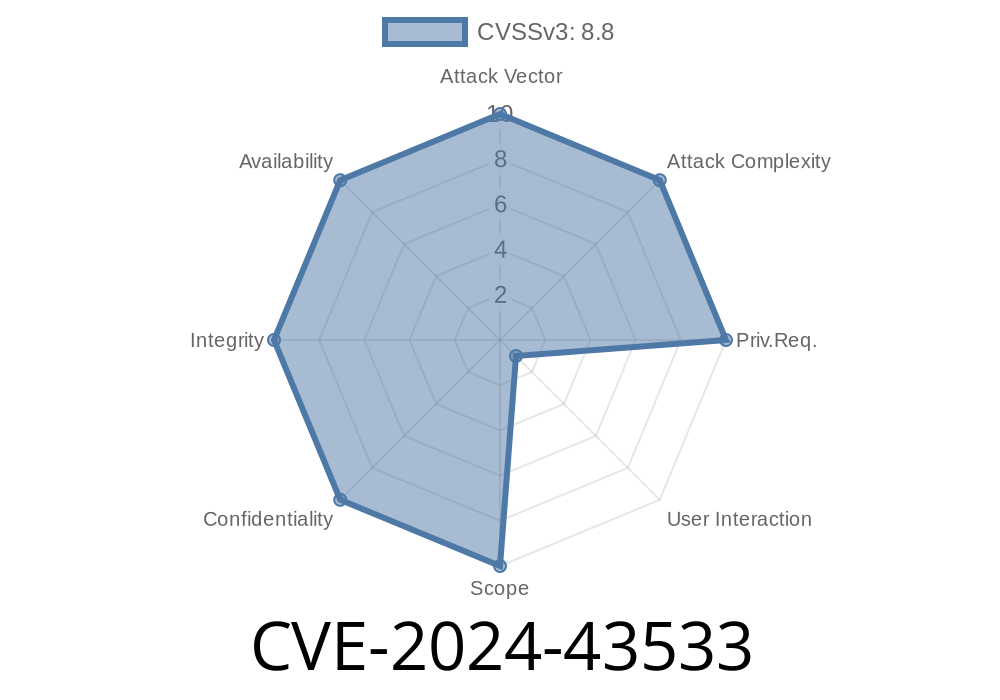The CVE-2024-43533 vulnerability came to light recently after the discovery that Remote Desktop Client (RDC) security holes exist. The vulnerability not only impacts RDC software used in Windows Operating Systems but also impacts other versions, such as the one for macOS. In this post, I will examine what makes this vulnerability a major risk and provide insight into its exploitation and remediation.
Background
Remote Desktop Client (RDC) software allows users to connect to and control a remote computer's desktop. It is primarily used for remote administration and technical support. The software relies on the Remote Desktop Protocol (RDP), which is a robust, well-documented, and standard method of networking that provides secure communication between remote computers.
The Vulnerability
CVE-2024-43533 is a vulnerability in the Remote Desktop Client (RDC) that allows an attacker to execute arbitrary code on the victim's computer when they initiate an RDP session with a malicious RDP server. This vulnerability results from a flaw in the way that RDC parses specific messages from the RDP server. If an attacker can trick the victim into connecting to their malicious RDP server, they can exploit this vulnerability to execute malicious code on the victim's machine, potentially leading to full system compromise.
Exploiting CVE-2024-43533
To exploit this vulnerability, an attacker must create a malicious RDP server that sends malformed packets, allowing them to remotely execute code on the victim's machine. Here's a simple code snippet demonstrating how a malicious server might send malformed packets to exploit this vulnerability:
import socket
server_socket = socket.socket(socket.AF_INET, socket.SOCK_STREAM)
server_socket.bind(("...", 3389)) # Bind server to IP address and RDP port 3389
server_socket.listen(5)
print("Malicious RDP server started, waiting for connections...")
while True:
# Accept incoming client connection
client_socket, client_address = server_socket.accept()
print(f"Incoming connection from {client_address}")
# Send malformed packet
malicious_packet = b"\x03\x00\x00\x13" # Example of corrupted packet header
client_socket.send(malicious_packet)
# Close connection
client_socket.close()
Once the attacker has set up their malicious RDP server, they need to lure the victim into connecting to it. This can be accomplished using several social engineering tactics, such as sending an email with a link to the malicious server or setting up a phishing website that prompts the victim to enter their RDP credentials.
Original References
The in-depth technical details and proof-of-concept code for CVE-2024-43533 can be found in the following reputable sources:
1. CVE Repository: https://cve.mitre.org/cgi-bin/cvename.cgi?name=CVE-2024-43533
2. National Vulnerability Database (NVD): https://nvd.nist.gov/vuln/detail/CVE-2024-43533
3. CERT Coordination Centre: https://www.kb.cert.org/vuls/id/289853
Although this vulnerability poses a significant risk, several steps can help mitigate it
1. Patch your systems: Keep your Remote Desktop Client software and the rest of your system up-to-date by installing the latest security patches.
2. Use network-level authentication: This feature requires users to authenticate before establishing an RDP connection, making it harder for attackers to exploit the vulnerability.
3. Limit RDP exposure: Only allow RDP access to necessary devices and users, and protect these connections with strong passwords and multi-factor authentication.
4. Be cautious when connecting to remote systems: Do not connect to unfamiliar or untrusted RDP servers, and do not click on suspicious links or enter login credentials on untrusted websites.
Conclusion
CVE-2024-43533 is a critical vulnerability that allows an attacker to execute arbitrary code on a victim's machine by exploiting a flaw in the Remote Desktop Client. By setting up a malicious RDP server and using social engineering tactics, an attacker can compromise a user's system without their knowledge. To protect yourself and your organization, it is crucial to stay informed, keep your software up-to-date, and practice safe computing habits.
Timeline
Published on: 10/08/2024 18:15:17 UTC
Last modified on: 12/10/2024 18:45:35 UTC
